Constructing Australian Residential Electricity Load Profile for Supporting Future Network Studies
Abstract
1. Introduction
2. Methodology
3. Factoring Load Growth
3.1. The Solar Load Profile
3.2. Residential Energy Storage Profile
3.3. Electrification
- Water heating, either by resistance heating or heat pump, will mostly use hot water storage. Existing practice shows water heating load is readily deferrable.
- Space heating is partially deferrable and improves with a longer building thermal time constant.
- Cooking is not deferrable but smaller in energy terms.
- A morning and evening peak caused by space heating and cooking.
- Water heating contributes to load at off-peak times.
3.4. Electric Vehicle Profile
- 32 A single phase or 7 kW
- 16 A to 32 A three phase, which is 11–22 kW.
- IBT EV consumers 876: IBT EV consumers staying with base rate—549, IBT EV consumers switching to EV rate—327.
- TOU EV consumers 813: TOU EV consumers staying with base rate-399, TOU EV consumers switching to EV rate—414.
- Home convenience charging 29%
- Home night charging 48%
- Home V2G charging 12%
- Public charging fast charge highway 5%
- Public charging solar aligned 6%.
- This paper has used the profile shown in Figure 6 to develop the net EV profile for years 2024 and 2030. The equation is expressed as follows:
3.5. Underlying Consumption Profile
4. Modelling Load Profiles
5. Insights into Constructed Profiles
6. Conclusions
Author Contributions
Funding
Data Availability Statement
Conflicts of Interest
References
- Hernando-Gil, I.; Li, F.; Collin, A.; Djokic, S. Development of sub-transmission network equivalents and after-diversity-demand values: Case study of the UK residential sector. In Proceedings of the 2016 18th Mediterranean Electrotechnical Conference (MELECON), Lemesos, Cyprus, 18–20 April 2016; pp. 1–6. [Google Scholar]
- Pimm, A.J.; Cockerill, T.T.; Taylor, P.G. The potential for peak shaving on low voltage distribution networks using electricity storage. J. Energy Storage 2018, 16, 231–242. [Google Scholar] [CrossRef]
- Barteczko-Hibbert, C. After Diversity Maximum Demand (ADMD) Report; Report for the ‘Customer-Led Network Revolution’ Project; Durham University: Durham, UK, 2015. [Google Scholar]
- Mcdaniel, G.; Gabrielle, A. Load diversity-its role in power system utilization. IEEE Trans. Power Appar. Syst. 1965, 84, 626–635. [Google Scholar] [CrossRef]
- McKenna, R.; Djapic, P.; Weinand, J.; Fichtner, W.; Strbac, G. Assessing the implications of socioeconomic diversity for low carbon technology uptake in electrical distribution networks. Appl. Energy 2018, 210, 856–869. [Google Scholar] [CrossRef]
- Giasemidis, G.; Haben, S.; Lee, T.; Singleton, C.; Grindrod, P. A genetic algorithm approach for modelling low voltage network demands. Appl. Energy 2017, 203, 463–473. [Google Scholar] [CrossRef]
- Net Zero. Available online: https://www.dcceew.gov.au/climate-change/emissions-reduction/net-zero (accessed on 2 April 2024).
- Graham, P.; Mediwaththe, C. Small-Scale Solar PV and Battery Projections 2022. 2022. Available online: https://aemo.com.au/-/media/files/stakeholder_consultation/consultations/nem-consultations/2022/2024-inputs-assumptions-and-scenarios-consultation/supporting-materials-for-2024/csiro-2022-solar-pv-and-battery-projections-report.pdf (accessed on 24 March 2024).
- Graham, P. Electric Vehicle Projections 2024: Update to the 2022 Projections Report; CSIRO: Canberra, Australia, 2024; Available online: https://aemo.com.au/-/media/files/stakeholder_consultation/consultations/nem-consultations/2024/2024-forecasting-assumptions-update-consultation-page/csiro---2024-electric-vehicle-projections-report.pdf?la=en (accessed on 28 March 2024).
- Griffith, S.; Ellison, J.; Calisch, S.; Cass, D. Household Electrification: Savings in the Suburbs. 2021. (webflow.com). Available online: https://615a1e5c7bec5c70d6d3f346_Castles and Cars Rewiring Australia Technical Study.pdf (accessed on 28 March 2024).
- AEMO. 2024 Inputs, Assumptions and Scenarios Report, Australia, 2024. Available online: https://aemo.com.au/-/media/files/major-publications/isp/2024/2024-inputs-assumptions-and-scenarios-report.pdf (accessed on 28 March 2024).
- Fila, M.; Taylor, G.A.; Hiscock, J.; Irving, M.R.; Lang, P. Flexible voltage control to support distributed generation in distribution networks. In Proceedings of the 2008 43rd International Universities Power Engineering Conference, Padua, Italy, 1–4 September 2008; pp. 1–5. [Google Scholar]
- Shi, Y.; Yu, T.; Liu, Q.; Zhu, H.; Li, F.; Wu, Y. An approach of electrical load profile analysis based on time series data mining. IEEE Access 2020, 8, 209915–209925. [Google Scholar] [CrossRef]
- Firoozjaei, M.D.; Kim, M.; Alhadidi, D. Time-series load data analysis for user power profiling. In Proceedings of the 2023 25th International Conference on Advanced Communication Technology (ICACT), Pyeongchang, Republic of Korea, 19–22 February 2023; pp. 382–387. [Google Scholar]
- Sandhaas, A.; Kim, H.; Hartmann, N. Methodology for generating synthetic load profiles for different industry types. Energies 2022, 15, 3683. [Google Scholar] [CrossRef]
- Omar, N.; Ariff, M.A.M.; Shah, A.F.I.M.; Mustaza, M.S.A. Estimating synthetic load profile based on student behavior using fuzzy inference system for demand side management application. Turk. J. Electr. Eng. Comput. Sci. 2020, 28, 3193–3207. [Google Scholar]
- Fischer, D.; Surmann, A.; Biener, W.; Selinger-Lutz, O. From residential electric load profiles to flexibility profiles–A stochastic bottom-up approach. Energy Build. 2020, 224, 110133. [Google Scholar] [CrossRef]
- Gao, B.; Liu, X.; Zhu, Z. A bottom-up model for household load profile based on the consumption behavior of residents. Energies 2018, 11, 2112. [Google Scholar] [CrossRef]
- Australian Energy Market Operator (AEMO). National Electricity & Gas Forecasting. 2024. Available online: https://forecasting.aemo.com.au/Electricity/AnnualConsumption/Operational (accessed on 28 March 2024).
- Griffith, S. Electrify: An Optimist’s Playbook for Our Clean Energy Future; MIT Press: Cambridge, MA, USA, 2022. [Google Scholar]
- Energy Efficiency Requirements. Available online: https://www.vba.vic.gov.au/consumers/home-renovation-essentials/energy-efficient-requirements (accessed on 28 March 2024).
- 6-Star Energy Equivalence Rating for Houses and Townhouses. 2015. Available online: https://www.epw.qld.gov.au/__data/assets/pdf_file/0014/5180/6starenergyequivalenceratingforhousesandtownhousesfactsheet.pdf (accessed on 28 March 2024).
- Motor Vehicle Census, Australia. Bureau of Statistics. Available online: https://www.abs.gov.au/statistics/industry/tourism-and-transport/motor-vehicle-census-australia (accessed on 28 March 2024).
- Graham, P.; Havas, L. Electric Vehicle Projections 2021; CSIRO: Canberra, Australia, 2021; Available online: https://aemo.com.au/-/media/files/electricity/nem/planning_and_forecasting/inputs-assumptions-methodologies/2021/csiro-ev-forecast-report.pdf (accessed on 28 March 2024).
- Qiu, Y.L.; Wang, Y.D.; Iseki, H.; Shen, X.; Xing, B.; Zhang, H. Empirical grid impact of in-home electric vehicle charging differs from predictions. Resour. Energy Econ. 2022, 67, 101275. [Google Scholar] [CrossRef]
- Graham, P.; Havas, L. Projections for Small-Scale Embedded Technologies; CSIRO: Canberra, Australia, 2020. [Google Scholar]
- Ratnam, E.L.; Weller, S.R.; Kellett, C.M.; Murray, A.T. Residential load and rooftop PV generation: An Australian distribution network dataset. Int. J. Sustain. Energy 2017, 36, 787–806. [Google Scholar] [CrossRef]
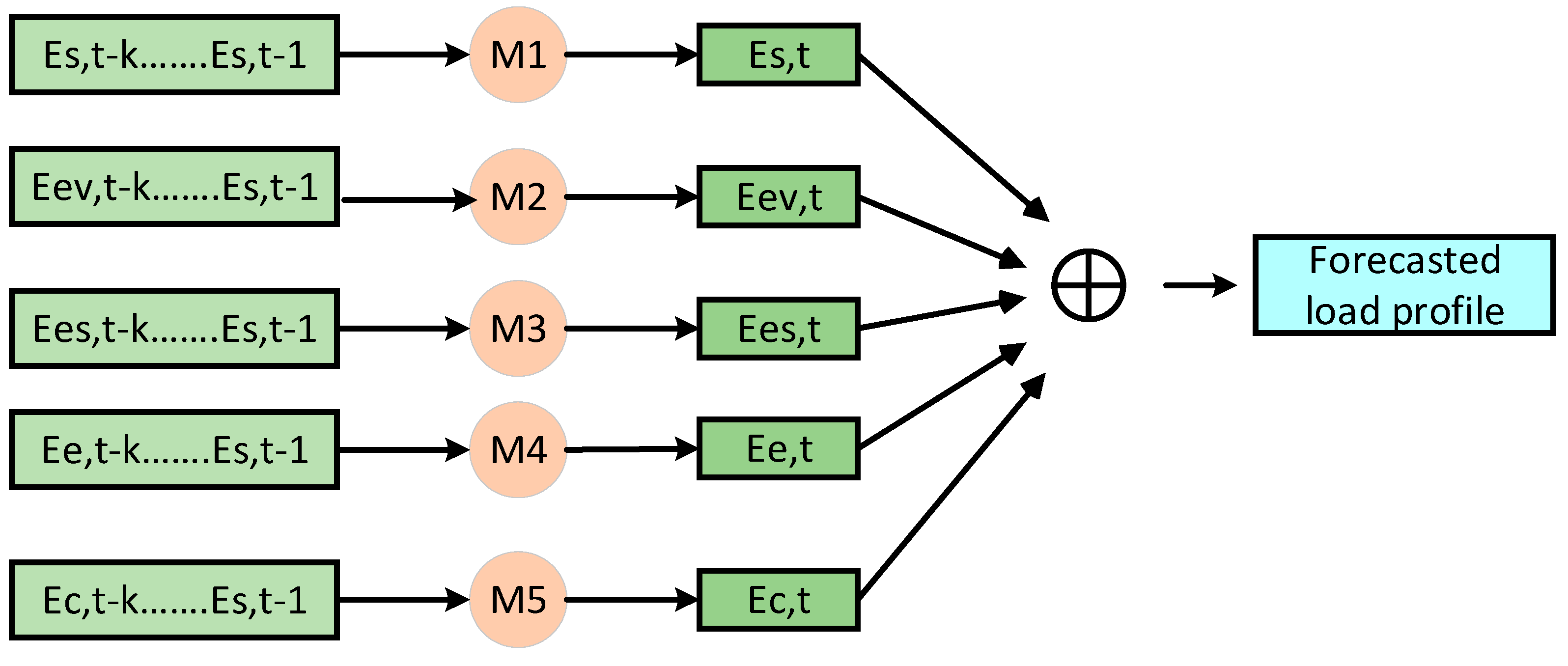
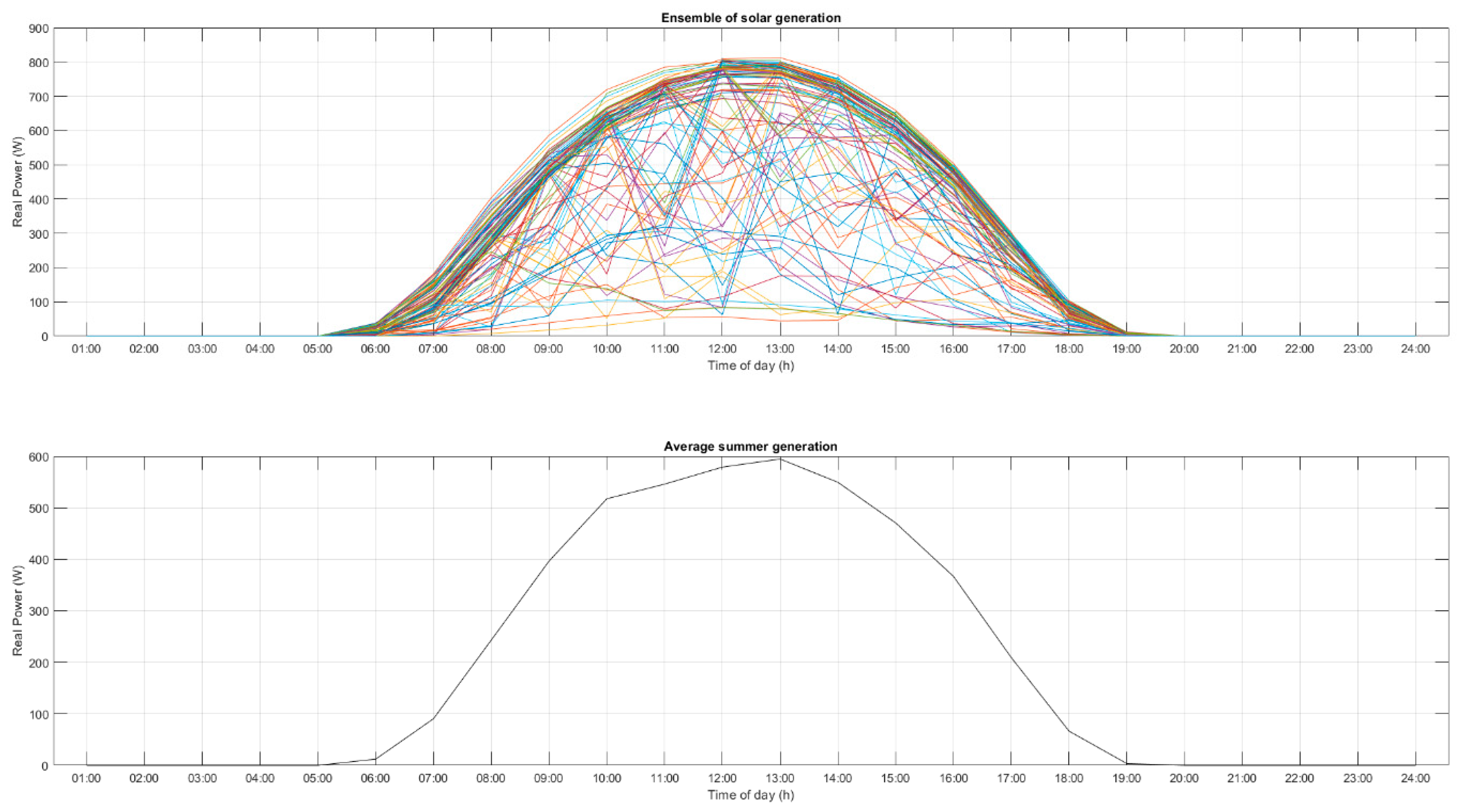
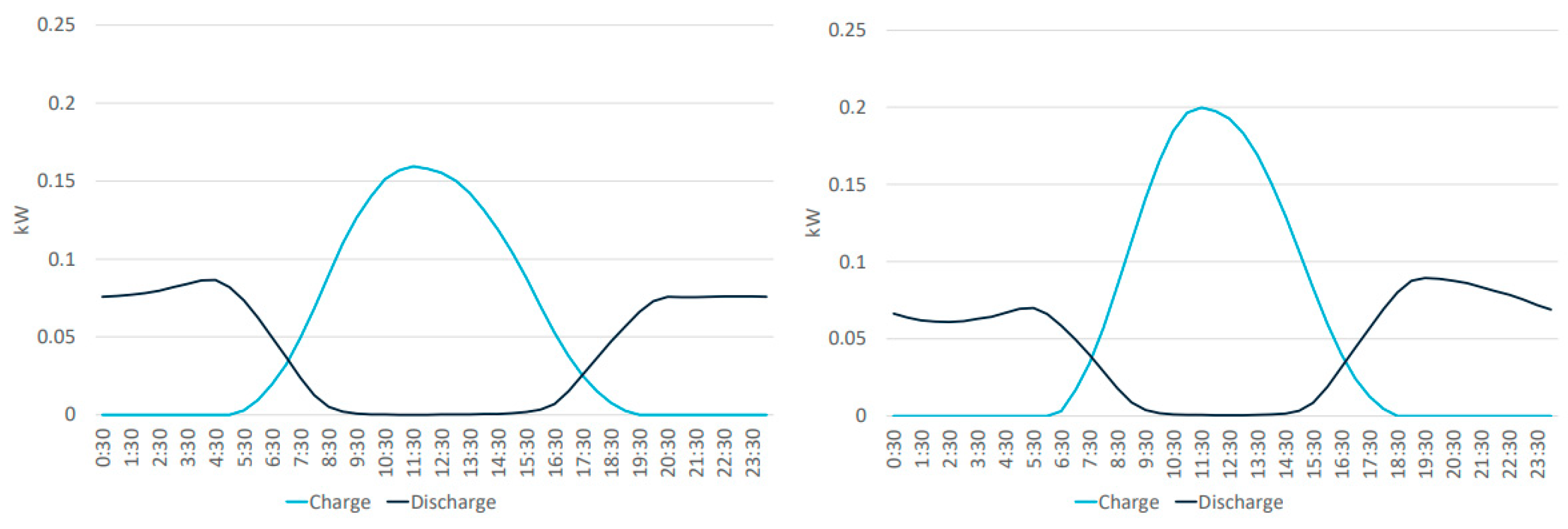
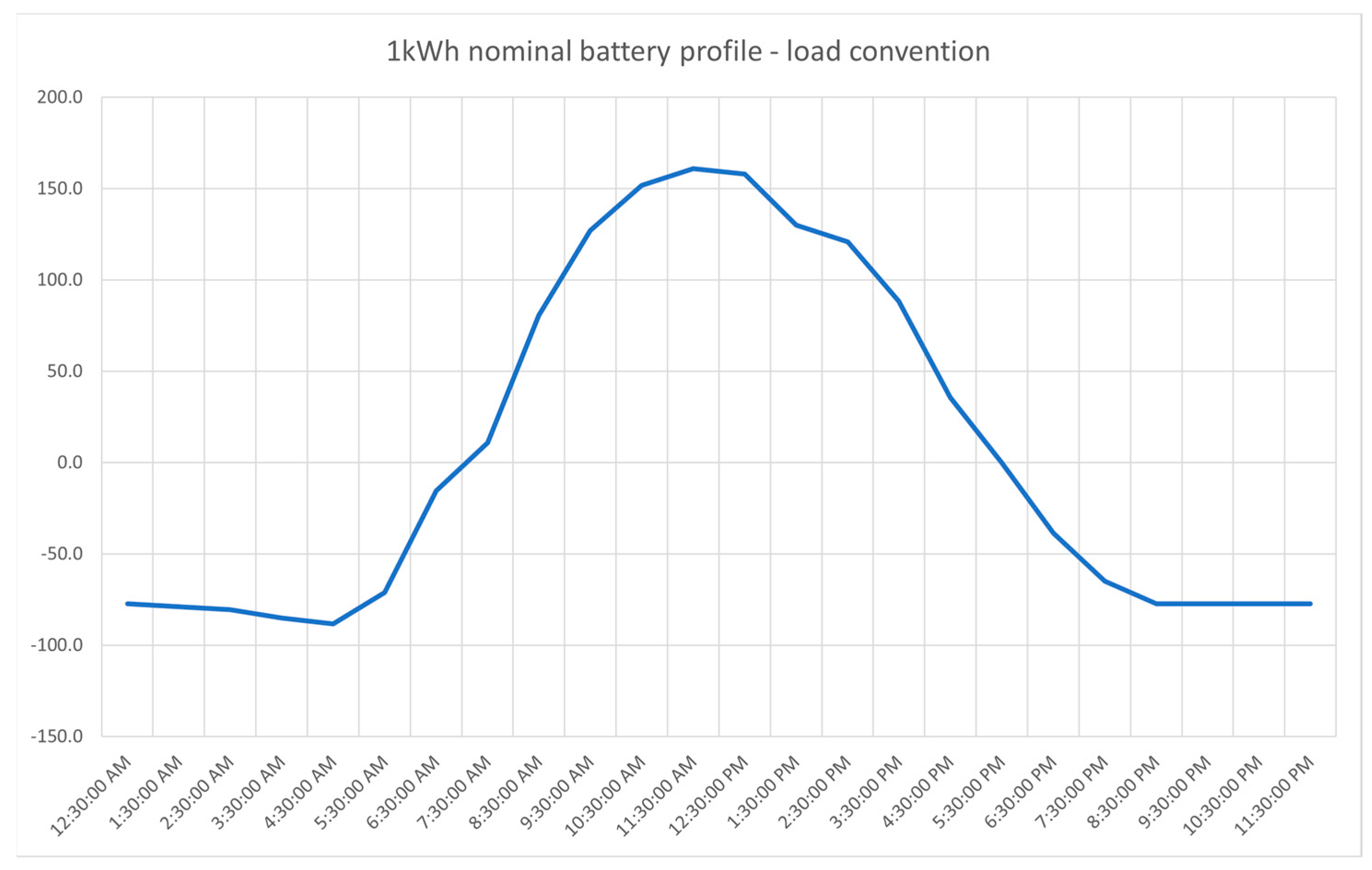

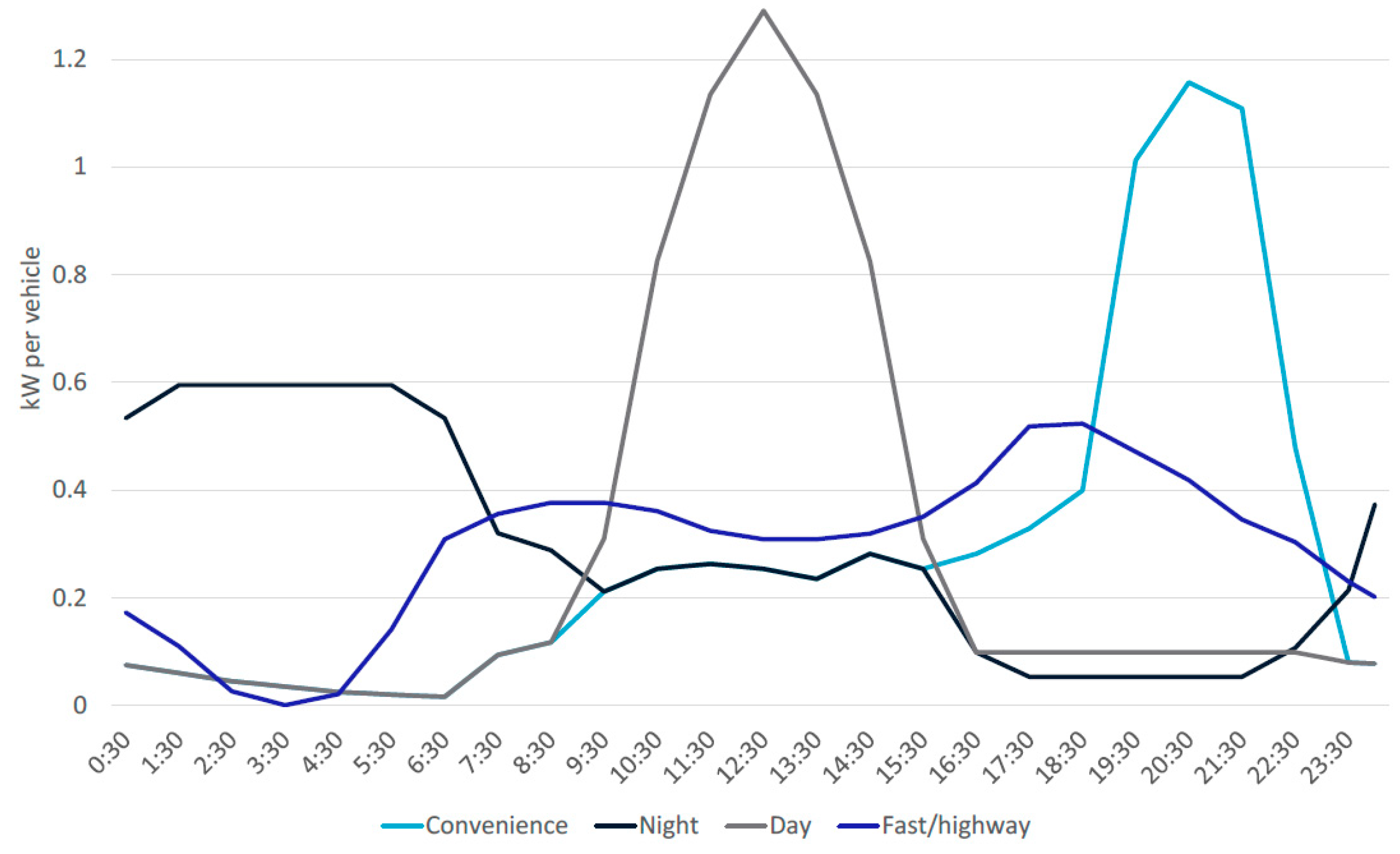
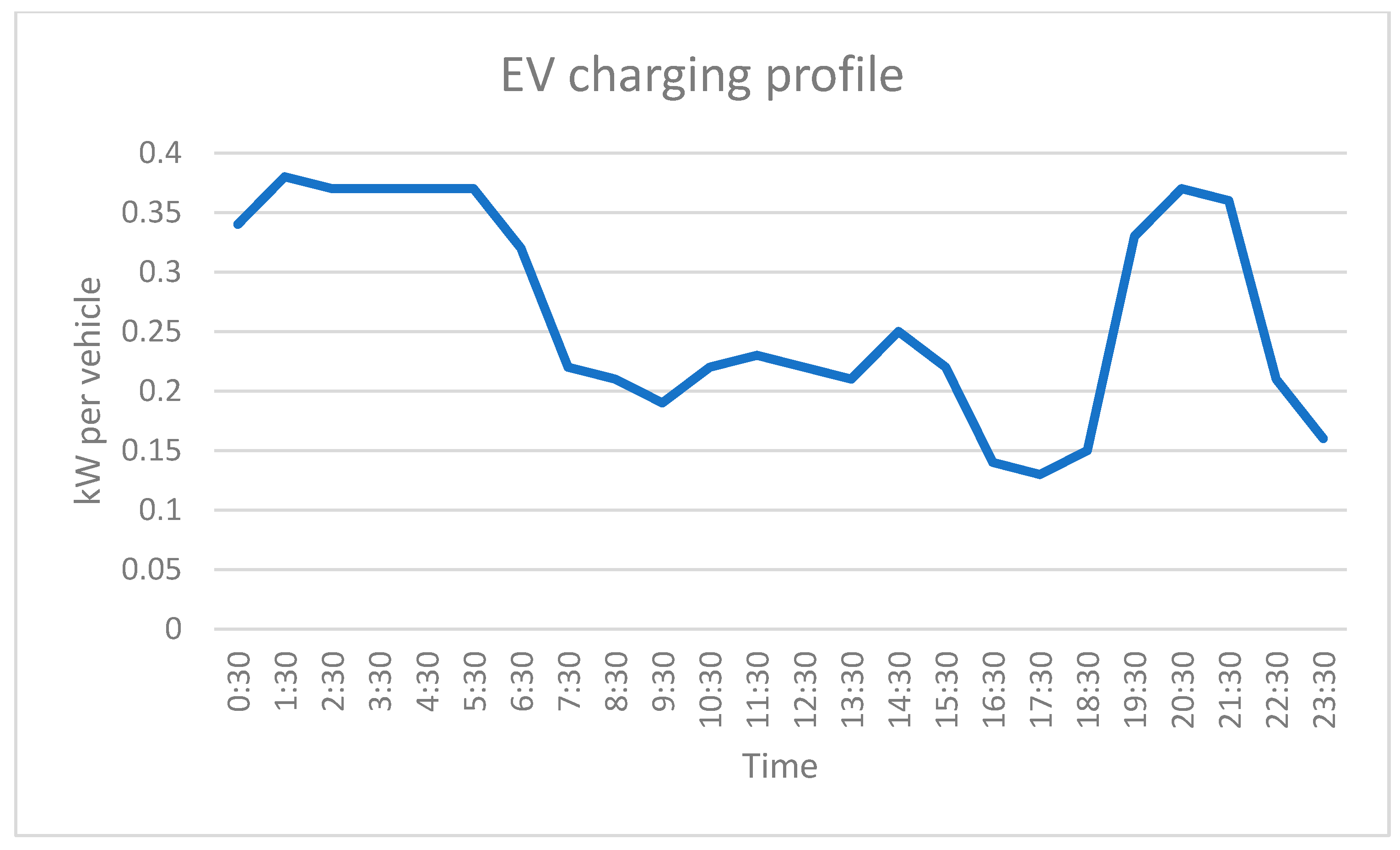
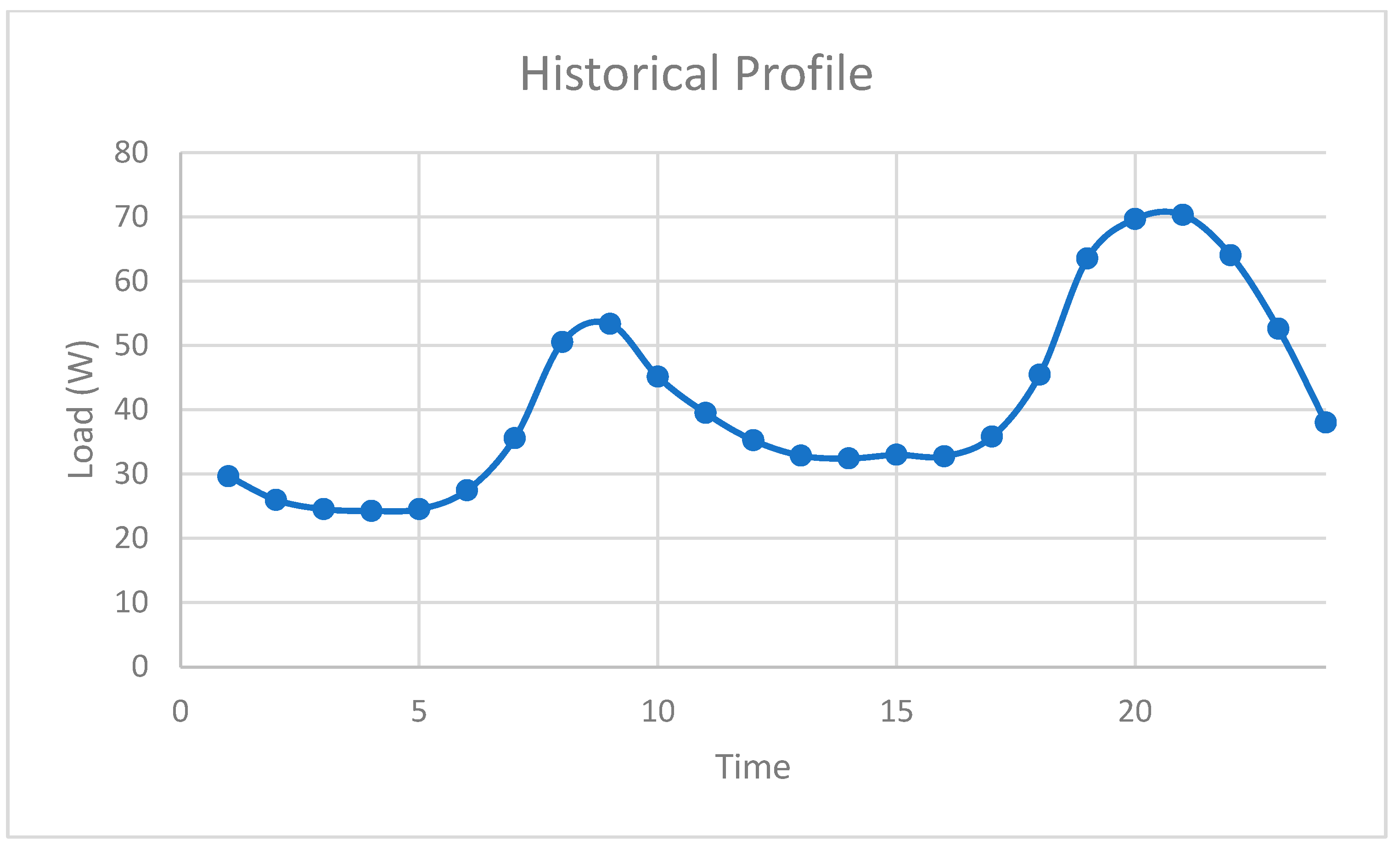
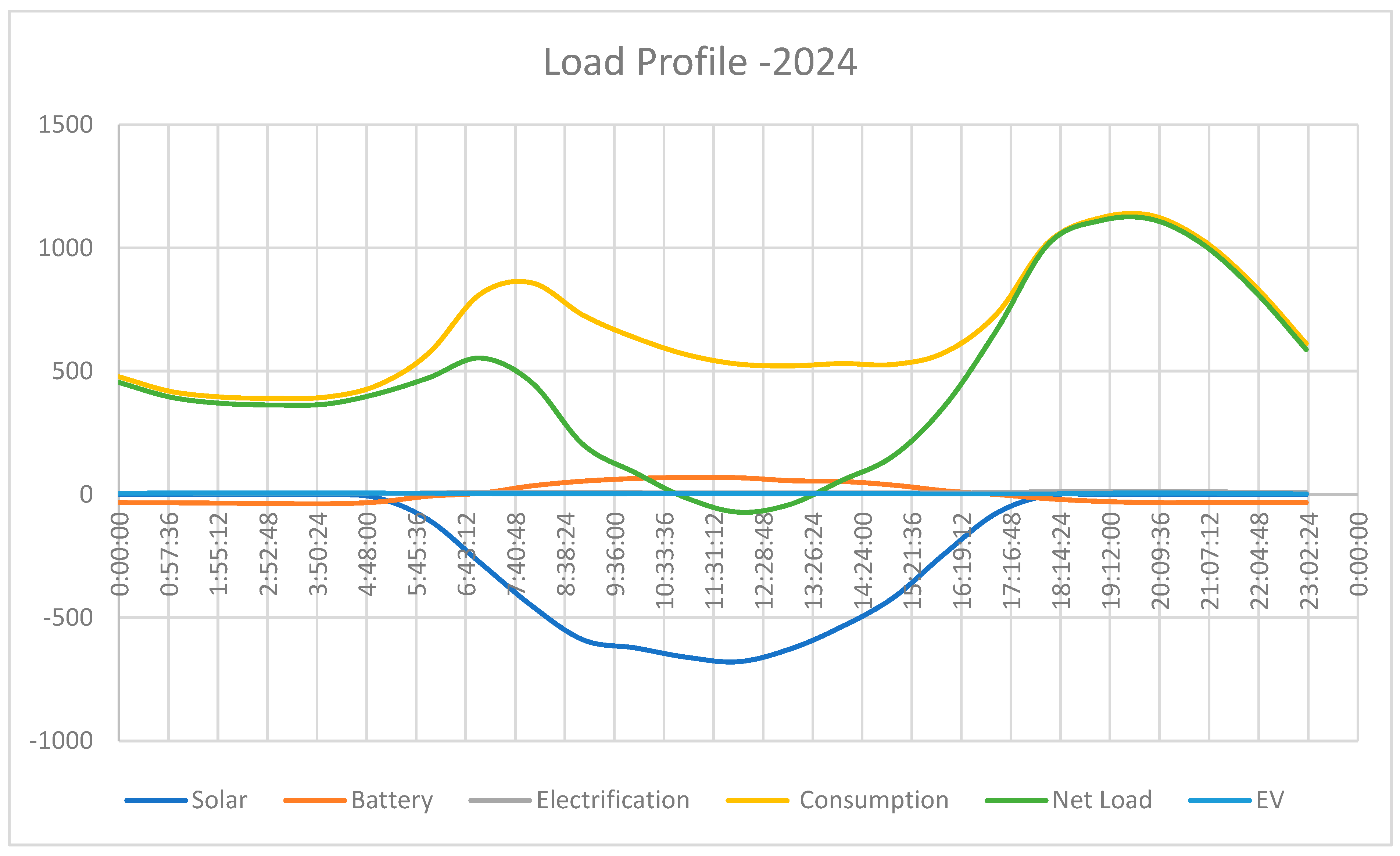
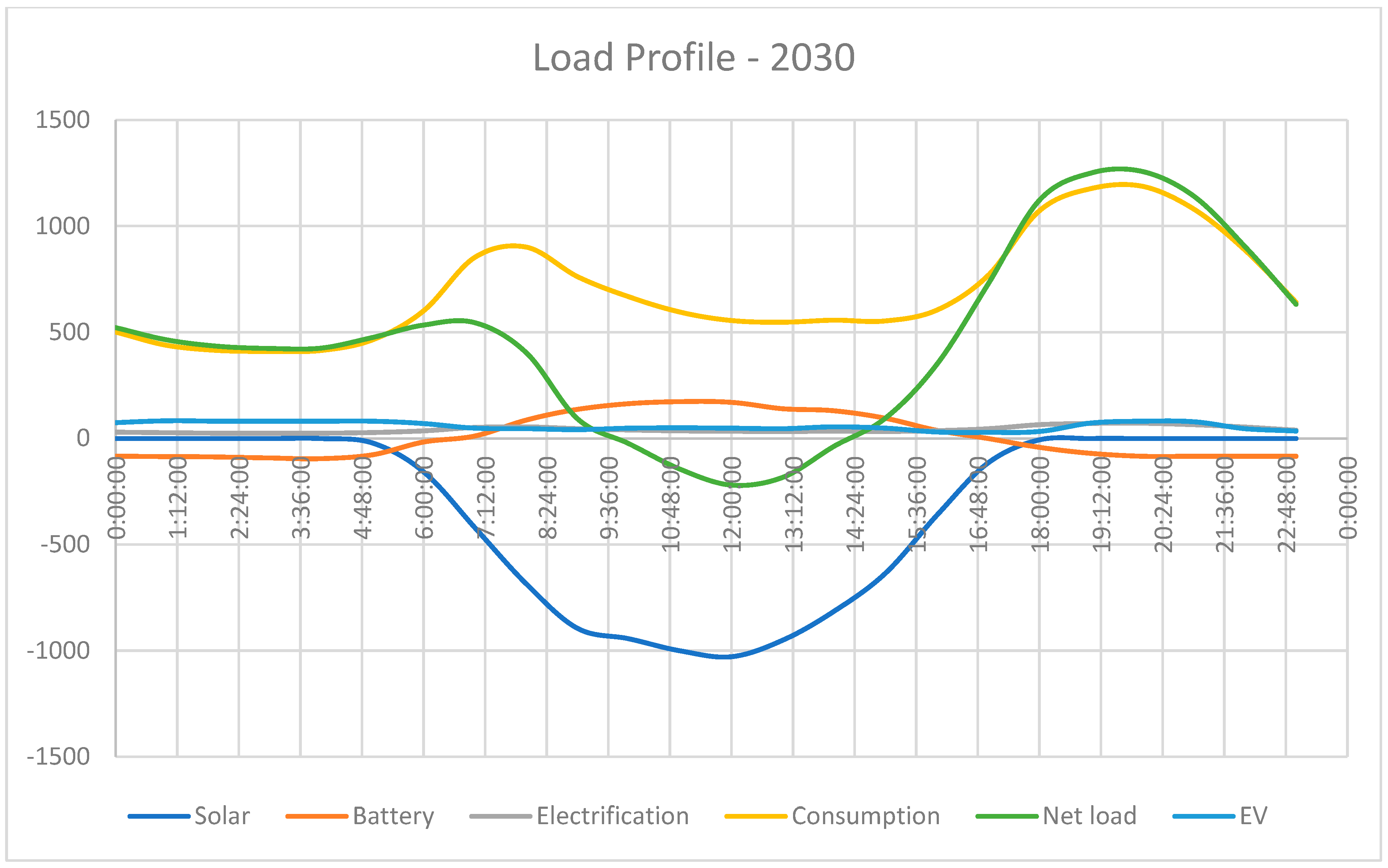

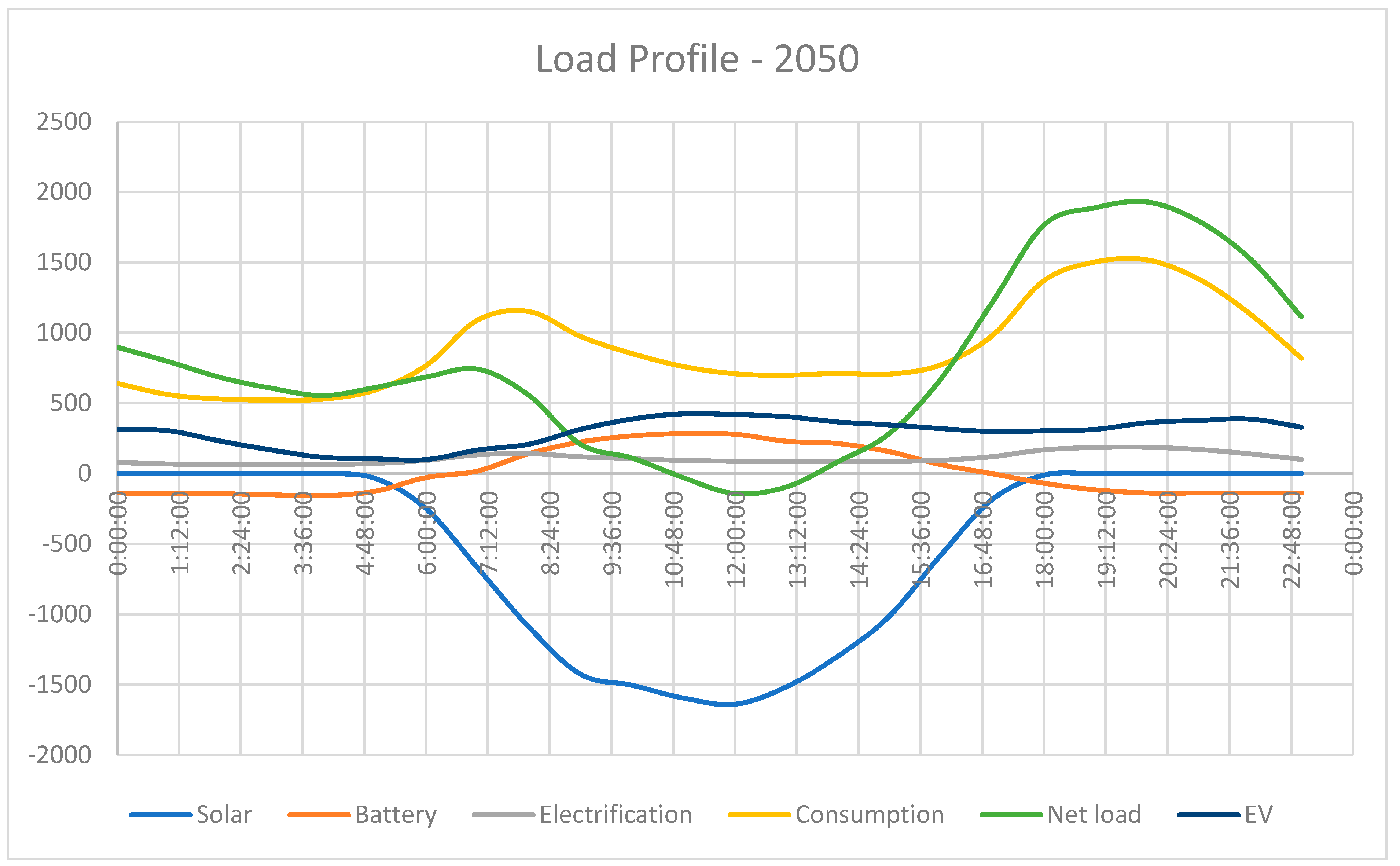
| Energy Component | 2024 | 2030 | 2040 | 2050 |
|---|---|---|---|---|
| Roof top PV—total | 23.1 | 39 | 62.5 | 86.9 |
| Residential | 18.7 | 31.1 | 48.7 | 63.7 |
| Business | 4.4 | 7.3 | 13.8 | 23.2 |
| Electric vehicles—total | 0.287 | 5.38 | 20.68 | 35.36 |
| Residential (68%) | 0.277 | 4.48 | 16.95 | 28.88 |
| Light Commercial Vehicle (LCV) (38%) | 0.01 | 0.904 | 3.73 | 6.49 |
| Electrification | 1.29 | 16.97 | 33.3 | 41.2 |
| Residential | 0.03 | 3.07 | 8.5 | 13.7 |
| Business | 1.26 | 13.9 | 24.8 | 27.5 |
| AEMO Residential demand | 36.6 | 25.9 | 10.7 | −4.1 |
| Corrections to residential demand | ||||
| Small non-scheduled generation (SNSG) offset | 1.6 | 2.3 | 3.1 | 4.6 |
| Electrification | 0.03 | 3.07 | 8.5 | 13.7 |
| Electric vehicles | 0.11 | 3.03 | 15.9 | 29.6 |
| Roof top PV supply to homes | 18.7 | 31.1 | 48.7 | 63.7 |
| Total correction | 20.44 | 39.5 | 76.2 | 111.6 |
| Underlying residential demand | 57.04 TWh | 65.4 TWh | 87.9 TWh | 107.5 TWh |
| Number of residential National NMIs | 9,698,322 | 10,600,406 | 12,135,686 | 13,657,214 |
| Underlying Consumption per NMI | ||||
| Annually | 5.88 MWh | 6.16 MWh | 7.24 MWh | 7.87 MWh |
| Daily | 16.1 kWh | 16.9 kWh | 19.8 kWh | 21.6 kWh |
| Solar generation per NMI | ||||
| Annually | 1.93 MWh | 2.93 MWh | 4.01 MWh | 4.66 MWh |
| Daily | 5.3 kWh | 8.03 kWh | 10.9 kWh | 12.8 kWh |
| Net Consumption per NMI | ||||
| Annually | 3.95 MWh | 3.23 MWh | 3.23 MWh | 3.21 MWh |
| Daily | 10.8 kWh | 8.87 kWh | 8.9 kWh | 8.8 kWh |
| EV Charging per NMI | ||||
| Annually | 0.029 MWh | 0.509 MWh | 1.704 MWh | 2.58 MWh |
| Daily | 0.081 kWh | 1.39 kWh | 4.67 kWh | 7.07 kWh |
| Equivalent vehicles per NMI | 0.015 | 0.22 | 0.69 | 1.05 |
| Electrification per NMI | ||||
| Annually | 0.003 MWh | 0.29 MWh | 0.7 MWh | 1 MWh |
| Daily | 0.009 kWh | 0.79 kWh | 1.9 kWh | 2.74 kWh |
| Time | Generation from 1 kWp (W) | 1 kWh/day Generation Profile (W) |
|---|---|---|
| 00:00:00 | 0.0 | 0.0 |
| 01:00:00 | 0.0 | 0.0 |
| 02:00:00 | 0.0 | 0.0 |
| 03:00:00 | 0.0 | 0.0 |
| 04:00:00 | 0.0 | 0.0 |
| 05:00:00 | 12.1 | 2.6 |
| 06:00:00 | 90.5 | 19.5 |
| 07:00:00 | 243.2 | 52.3 |
| 08:00:00 | 396.4 | 85.3 |
| 09:00:00 | 517.5 | 111.4 |
| 10:00:00 | 546.0 | 117.5 |
| 11:00:00 | 578.9 | 124.6 |
| 12:00:00 | 594.7 | 128.0 |
| 13:00:00 | 549.5 | 118.3 |
| 14:00:00 | 470.6 | 101.3 |
| 15:00:00 | 366.8 | 79.0 |
| 16:00:00 | 209.3 | 45.1 |
| 17:00:00 | 66.5 | 14.3 |
| 18:00:00 | 3.5 | 0.8 |
| 19:00:00 | 0.0 | 0.0 |
| 20:00:00 | 0.0 | 0.0 |
| 21:00:00 | 0.0 | 0.0 |
| 22:00:00 | 0.0 | 0.0 |
| 23:00:00 | 0.0 | 0.0 |
| Total | 4645.4 Wh | 1000.0 Wh |
| Year | Installed Capacity (GWh) | NMI Number | Capacity per Customer |
|---|---|---|---|
| 2024 | 4.2 | 9,698,322 | 0.43 kWh |
| 2030 | 11.5 | 10,600,406 | 1.08 kWh |
| 2040 | 17.8 | 12,135,686 | 1.47 kWh |
| 2050 | 24.2 | 13,657,214 | 1.77 kWh |
| Parameter | 2024 | 2030 | 2040 | 2050 |
|---|---|---|---|---|
| Net energy per NMI | 10.9 kWh | 11.2 kWh | 15.5 kWh | 18.5 kWh |
| Solar generation per NMI | 5.3 kWh | 8.03 kWh | 10.9 kWh | 12.8 kWh |
| Gross Energy per NMI | 16.2 kWh | 19.23 kWh | 26.4 kWh | 31.3 kWh |
| Maximum demand | 1116 W | 1257 W | 1659 W | 1930 W |
| Minimum demand | −71 W | −219 W | −169 W | −140 W |
Disclaimer/Publisher’s Note: The statements, opinions and data contained in all publications are solely those of the individual author(s) and contributor(s) and not of MDPI and/or the editor(s). MDPI and/or the editor(s) disclaim responsibility for any injury to people or property resulting from any ideas, methods, instructions or products referred to in the content. |
© 2024 by the authors. Licensee MDPI, Basel, Switzerland. This article is an open access article distributed under the terms and conditions of the Creative Commons Attribution (CC BY) license (https://creativecommons.org/licenses/by/4.0/).
Share and Cite
Mumtahina, U.; Alahakoon, S.; Wolfs, P.; Liu, J. Constructing Australian Residential Electricity Load Profile for Supporting Future Network Studies. Energies 2024, 17, 2908. https://doi.org/10.3390/en17122908
Mumtahina U, Alahakoon S, Wolfs P, Liu J. Constructing Australian Residential Electricity Load Profile for Supporting Future Network Studies. Energies. 2024; 17(12):2908. https://doi.org/10.3390/en17122908
Chicago/Turabian StyleMumtahina, Umme, Sanath Alahakoon, Peter Wolfs, and Jiannan Liu. 2024. "Constructing Australian Residential Electricity Load Profile for Supporting Future Network Studies" Energies 17, no. 12: 2908. https://doi.org/10.3390/en17122908
APA StyleMumtahina, U., Alahakoon, S., Wolfs, P., & Liu, J. (2024). Constructing Australian Residential Electricity Load Profile for Supporting Future Network Studies. Energies, 17(12), 2908. https://doi.org/10.3390/en17122908









